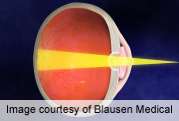(HealthDay)—Most children treated for moderate amblyopia when younger than 7 years have good visual acuity at 15 years of age, according to a study published in the July issue of JAMA Ophthalmology.
Michael X. Repka, M.D., from Johns Hopkins University in Baltimore, and colleagues randomly assigned 419 children with amblyopia (visual acuity, 20/40 to 20/100) to either patching (minimum of six hours/day) or atropine sulfate eye drops (1 percent; one drop daily), for six months. After six months, treatment was at the discretion of the investigator. An unselected subgroup of 188 children were enrolled into long-term follow-up two years after enrollment.
The researchers found that mean visual acuity in the amblyopic eye measured at 15 years was approximately 20/25 in 147 participants; 59.9 percent of amblyopic eyes had visual acuity of 20/25 or better and 33.3 percent had visual acuity of 20/20 or better. At 15 years of age, the mean interocular acuity difference (IOD) was 2.1 lines, with 48.3 percent having an IOD of two or more lines and 71.4 percent having an IOD of one or more lines. Nine participants (aged 10 to 15 years; 6.1 percent) had prescribed treatment other than spectacles. At the 15-year examination, better visual acuity was achieved in those who were younger than 5 years at the time of entry into the randomized clinical trial, compared with those aged 5 to 6 years (P < 0.001). There were no significant differences in visual acuity of amblyopic and fellow eyes at 15 years of age when comparing original treatment with atropine or patching (P = 0.44 and 0.43, respectively).
"The results indicate that improvement occurring with amblyopia treatment is maintained until at least 15 years of age," the authors write.
More information:
Abstract
Full Text (subscription or payment may be required)
Journal information: JAMA Ophthalmology
Copyright © 2014 HealthDay. All rights reserved.



















